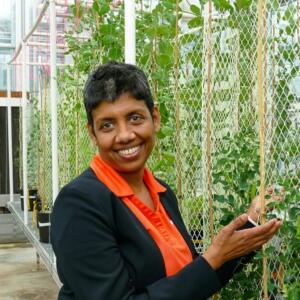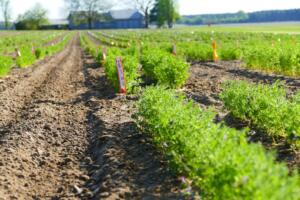A breeding pipeline is growing improved pulse crops for natural farmers within the southeast
Written by Brian Geier

New cultivars of pulse crops (lentils, chickpeas, and subject peas) might quickly be out there to natural farmers! These improved varieties, below improvement by way of a challenge led at Clemson State College (CSU), will:
- be appropriate for crop rotations with money crops at the moment being grown on natural farms in North and South Carolina,
- have excessive protein content material and high quality, and
- be local weather resilient (to warmth, drought, and chilly stress).
The Principal Investigator on the challenge, Dr. Dil Thavarajah, is an internationally-recognized chief in pulse biofortification (breeding for dietary traits) who leads CSU’s Pulse Biofortification and Dietary Breeding Program. Her challenge, Sustainable, high-quality natural pulse proteins: natural breeding pipeline for different pulse-based proteins, is funded by USDA/NIFA’s Natural Agriculture Analysis and Extension Initiative (OREI), a program OFRF’s advocacy work goals to bolster and defend.
Dr. Thavarajah brings an in depth background in pulse breeding and a world focus to the trouble to develop natural cultivars for farmers within the southeast.
“I believe the worldwide element is essential as a result of pulse crops particularly are inbred and they aren’t very genetically numerous. Main universities with pulse breeding applications within the US are all standard. We have to change materials as a result of the fabric they develop for standard isn’t going to work with natural. Natural is an entire totally different ball sport.” -Dr. Dil Thavarajah
 The challenge builds on a earlier OREI grant that helped to determine varieties that labored nicely in natural crop rotations with sorghum. These varieties at the moment are being evaluated to determine these with greater protein and sugar content material, and higher protein high quality (measured each by digestibility and shopper choice). Dr. Thavarajah calls her strategy “participatory breeding” that features each shoppers and farmers within the course of. Curiously, greater sugar content material not solely makes pulse crops sweeter and most popular by shoppers, but additionally makes the plant extra local weather resilient. Having extra sugar alcohols within the crops means the crops usually tend to stay wholesome by way of drought stress, excessive warmth, or chilly snaps.
The challenge builds on a earlier OREI grant that helped to determine varieties that labored nicely in natural crop rotations with sorghum. These varieties at the moment are being evaluated to determine these with greater protein and sugar content material, and higher protein high quality (measured each by digestibility and shopper choice). Dr. Thavarajah calls her strategy “participatory breeding” that features each shoppers and farmers within the course of. Curiously, greater sugar content material not solely makes pulse crops sweeter and most popular by shoppers, but additionally makes the plant extra local weather resilient. Having extra sugar alcohols within the crops means the crops usually tend to stay wholesome by way of drought stress, excessive warmth, or chilly snaps.
In the end, although, the farmer-collaborators are the centerpiece of the breeding program. “I don’t suppose I may very well be profitable with out my growers,” she admits. The willingness of farms like W.P. Rawl and Sons to trial new varieties and crop rotations led to profitable grant proposals and will very nicely result in new cultivars being launched to farmers very quickly. To acknowledge this, Dr. Thavarajah seems ahead to releasing new varieties that bear the names and legacies of the farmers concerned within the challenge.
Be taught extra about Dr. Thavarajah’s work (together with recommendation for fellow researchers making use of for OREI funding) by watching the next brief video interview with OFRF, and comply with her work to remain up to date on the discharge of biofortified pulse crops for natural farmers within the southeast!

